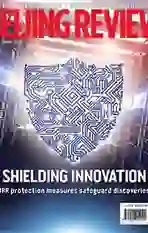Key Terms to Understand Reform and Opening Up
2019-02-13
The China Academy of Translation has analyzed prevailing terms concerning the reform and opening-up policy and translated them into a number of foreign languages. The research institute is affiliated with the China International Publishing Group, the countrys leading international publisher. In each issue, Beijing Review presents a selection of these keywords to help readers more deeply understand this program.
RMBs Inclusion in SDR Basket
On November 30, 2015, the International Monetary Fund (IMF) announced the inclusion of the Chinese renminbi (RMB) in the special drawing rights (SDR) basket as a fi fth currency, along with the U.S. dollar, the euro, the Japanese yen and the British pound. Effective from October 1, 2016, the RMB became a“global currency” in a real sense.
The SDR is a supplementary international reserve asset created by the IMF in 1969. It is the unit of account of the IMF and some other international organizations, known as “paper gold.” Once a countrys currency is added to the basket, it will become a global currency. The RMBs inclusion was the first time the IMF had added the currency of an emerging economy as a reserve currency. This greatly enhances the RMBs status.
The inclusion was the result of decades of reform and opening up of Chinas financial sector. It showed the international communitys recognition of Chinas composite strength and reform and opening up. It also marked a starting point for the Chinese fi nancial system to further integrate into the international economic and fi nancial system and take up new duties and obligations. It will spur Chinas internal fi nancial reform and opening of capital accounts.
The Belt and Road Initiative
The Belt and Road Initiative—Chinas proposal to cooperate with other countries in building a Silk Road Economic Belt and a 21st-Century Maritime Silk Road—was unveiled by Xi during his visits to Central and Southeast Asia in September and October 2013. It was a strategic decision taken by the central leadership as part of a new process of further opening up to the outside world. It also serves as an important platform for building a community with a shared future for humanity.
The initiative focuses on policy coordination, connectivity of infrastructure and facilities, unimpeded trade, financial integration and close people-to-people ties through a consultative process and joint efforts, with the goal of bringing benefits to all. It aims to build a community with shared interests and responsibility with a shared future. The Belt and Road will be a path to peace, prosperity and openness through innovative programs and friendly engagement.
Over the past five years, more than 100 countries and international organizations have expressed support for the initiative and participated in related activities. The UN General Assembly and Security Council have also referred to the initiative in some of their resolutions. The vision of the Belt and Road is gradually being translated into action, and success stories have begun to emerge.
BRICS Cooperation Mechanism
BRIC is an acronym coined by the U.S. Goldman Sachs in 2003 to call the four promising emerging economies: Brazil, Russia, India and China. The foreign ministers of these four countries had their fi rst meeting on the margins of the UN General Assembly in September 2006, and this has since become an annual event. In June 2009, the leaders of BRIC held a formal meeting in Russia, thus starting their partnership under the BRIC mechanism. With the formal inclusion of South Africa in December 2010, the group became BRICS.
The BRICS mechanism has seen improvements with pragmatic cooperation in dozens of fi elds such as trade and economy, banking and fi nance, education, science and technology, culture and think tanks. Under the inter-governmental mechanism, there are summits of state leaders, ministerial meetings, seminars and forums, as well as multi-layer supportive mechanisms such as the BRICS interbank cooperation mechanism, the BRICS Business Council, the BRICS contingent reserve arrangement, the New Development Bank, and the think tank symposiums.
During the 2017 BRICS Summit in Xiamen, Chinese President Xi Jinping proposed the BRICS Plus approach to cooperation. He suggested more dialogue between BRICS and other developing countries and their organizations to build extensive partnerships, make more friends, and turn BRICS into an influential platform for South-South cooperation. By early 2018, the BRICS countries had set up some 60 mechanisms for cooperation, covering trade and economy, finance, agriculture, education, science and technology, culture and think tanks.
